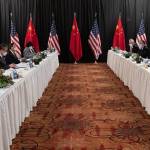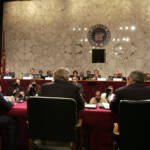Unpacking and Understanding Media Bias: Did Objective Journalism Ever Exist?

The late 19th and early-to-mid 20th centuries marked both the rise and fall of objectivity in American news media. Even so, the golden age of objectivity, paradoxically characterized by both elitism and ethicism, was anything but an era of pure objective journalism.
This is the ninth part in a Citizen Truth series on media bias and the history of the press, read the first parts below.
Part 1 | Part 2 | Part 3 | Part 4 | Part 5 | Part 6 | Part 7 | Part 8
The Lede Is Born
Throughout the course of the Civil War, journalists had maintained the practice of writing in chronological order, with events unfolding in news articles in the same order they occurred in real life.
In 1862 as the Civil War raged on, Edwin Stanton replaced Simon Cameron as Lincoln’s war secretary following Cameron’s resignation. Soon thereafter, Stanton obtained Lincoln’s authorization to control the war telegraphs, and within the short span of two weeks, had all telegraph lines rerouted through his office. Stanton’s dispatches, circulated as his war diary, became the lead stories each day.
Stanton wrote in a “just the facts” manner, with details conveyed in descending order from most to least important. Although novel at the time, this style is known today as the inverted pyramid. The most important fact in each article became the headline, or lede, and the first paragraph contained the most newsworthy facts. This style relegated the less important facts to the remaining paragraphs, in descending order of importance.
Ushering in Objective Journalism
By the end of the Civil War, the news industry in the U.S. began its temporary transition out of the blind party loyalty that had epitomized American journalism up until that point, a shift driven in large part by the introduction of the telegraph and the rise of the penny press. Though a short-lived phenomenon in American news, objective journalism got a bit of a boost with the establishment of journalistic guidelines and codes of ethics.
Debate surrounding the objectivity and purpose of newspapers took place throughout the late 19th and early 20th centuries. New York Tribune editor Horace Greeley created guidelines surrounding objectivity for his newspaper’s reporters in an effort to ensure that all sides of arguments received coverage, while Edwin Godkin of the Nation argued that newspapers should mold public opinion through reporting. Godkin also believed that the masses lacked the wits to consider or debate policy and therefore, newspapers should gear their writing toward the elite, whom he considered more capable in such matters.
Throughout the late 1800s and early 1900s, many newspapers developed their own standards and codes of ethical conduct. In 1896 Adolph Ochs purchased the failing, bankrupt New York Times and directed his reporters to write news objectively, “give the news impartially, without fear or favor, regardless of party, sect or interests involved.” Oswald Garrison Villard, publisher of The Nation and the New York Evening Post, stressed the importance of objectivity and reporting “both sides of every issue.” The Washington Post’s set of principles, established and published in 1935, still appear on its website today.
Founded in 1912, the American Society of Newspaper Editors (ASNE) released a more comprehensive and universally applicable code of ethics (statement of principles) in 1922. ASNE held that editorial partisanship that intentionally deviated from the truth did a disservice to and subverted the primary purpose and requirement of journalism.
In creating these codes of ethics and principles, editors, publishers, writers and the ASNE promised readers they would adhere to the truth and provide unbiased reports, but these promises directly contradicted the elitist perception at the time: that journalists and newspapers needed to shape the views of their readership for their own good and the good of the country. When molding public opinion, they did so in keeping with their own values, biases and world-views. So, to say the news industry completely abandoned bias and partisanship, or exhibited anything remotely resembling pure objective journalism in the late 19th and early 20th centuries would be, at a minimum, disingenuous.
Still, the number of editors in favor of objectivity continued to grow from the late 19th century, and ultimately, they attempted to solve the problem of biased versus objective reporting by separating news and editorial columns into distinct sections of newspapers.
As some journalists gave the appearance of eschewing bias in their push toward objectivity, some progressive scholars argued that the mere acts of story selection and the selecting of facts for inclusion in articles allowed for the interference of the journalists’ or editors’ biases. In contemporary communication and media studies, these theories are known as gate-keeping and selection bias, and we know from modern studies of journalism and media that this line of thinking is indeed valid.
Facts themselves may be objective, but the publishing of one fact or story over another is informed by the selector’s own biases. No one person could possibly include every fact related to a story, so writers and editors must make choices. Those choices are naturally defined by the selectors’ world-views, and consequently by what the selectors view as imperative to the telling of the story. So, it is important to know that even during the most objective era in the history of American journalism, journalists and newspapers operated according to a conflicted sense of elitist objectivity.
Bias and censorship never actually ceased to exist. The value-free or objective approach attempted to eradicate bias while the progressive approach not only accepted but also embraced and emboldened it. Objective journalism and journalists fought to separate fact from value so much so that they created and supported a cynical system of reporting that obligated them to a sort of constant criticism of society, and with that obligation to criticize came a dark and overshadowing aspect to every story. Good stories were not good enough, everything needed a downside lest it be construed as uncritical.
Does Getting Both Sides of the Story Create Objective Journalism?
Does the mere juxtaposition of two contradictory perspectives of a given issue truly equate to objectivity? Similar to the 21st century, objectivity and balance did not necessarily mean sharing both sides of a story equally, rather it meant contrasting the rightness of one side with the wrongness of the other.
Conducting oral interviews of sources on both sides of an issue became a favored method of ensuring objectivity from about 1900 onward, regardless of whether both sides had rational standing or validity. In the minds of journalists and editors. This alone constituted fairness in reporting.
While seemingly well-intentioned, this practice can have repercussions that achieve the opposite of the intent. First, getting “both” sides of a story implies that there are just two sides to every story when in fact there may be more. Alternatively, it implies that there are always two sides to a story when in fact there may be just one. Taken as a whole, the implication here is that truth may not actually exist, that right, wrong and truth are always relative and subjective.
The 1920s
Elitist Walter Lippmann — the journalist, media critic and amateur philosopher who assisted Woodrow Wilson with the writing of the Fourteen Points during the Paris Peace Conference (Treaty of Versailles) at the end of WWI— contended that the news industry posed a greater threat to human freedom than the state. A proponent for the value-laden, biased style of news writing, he argued that news and truth are not synonymous and that journalists had a responsibility to bring hidden facts to light by painting a picture for citizens to act upon.
Casper Yost, first president of the American Society of News Editors (ASNE) and longtime editor of the St. Louis Globe-Democrat contended that “No people have ever progressed morally who did not have conceptions of right and wrong impressed upon them by moral leadership.” And by moral leadership, Yost meant himself and his colleagues.
Facts alone no longer sufficed; journalists needed to first establish the truth prior to reporting the facts. Whose truth? Typically, their own. Much to the chagrin of journalists, and despite great effort on their part, news readers preferred the appearance and impossibility of pure objectivity. The public just wanted facts.
Academia vs. Journalism
The exact duration of the era of objective journalism is widely disputed. While former Columbia Journalism Review editor James Boylan argued that journalistic objectivity ended with the close of World War II and FDR’s death, Si Sheppard and Jim Kuypers argue that it began during the late 19th century and lasted until the 1970s. The latter lay credit for its demise at the feet of the Kennedy assassination, Vietnam, controversial President Lyndon Johnson and finally, Watergate. In conjunction with the social and political turmoil of the era, these events brought about a full-scale revival of partisan news in the U.S.
Michael Barone’s 1996 article, The Return of Partisan Journalism, however, discussed “the high tide of partisan media” in 1920s New York, which calls into question whether objective journalism ever really existed in the first place.
If objectivity ever existed, journalists had a short-lived love affair with it. Even according to the most generous and optimistic academic opinions, it spanned just several short decades of the U.S.’s few hundred-year history. At best, objectivity began in the late 19th century, diminished in the 20th century and abated almost entirely by the mid-20th century.
Jim Kuypers best summed up the climate of the era in his book Partisan Journalism: A History of Media Bias in the United States when he said, “Journalism had, for the most part, committed itself to objectivity, but as we have seen, a very powerful undercurrent of elite, moralistic progressivism ran under the surface, constrained only minimally by loosely constructed concepts of professionalism.”







































